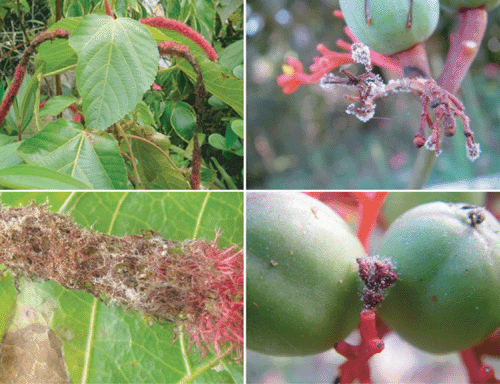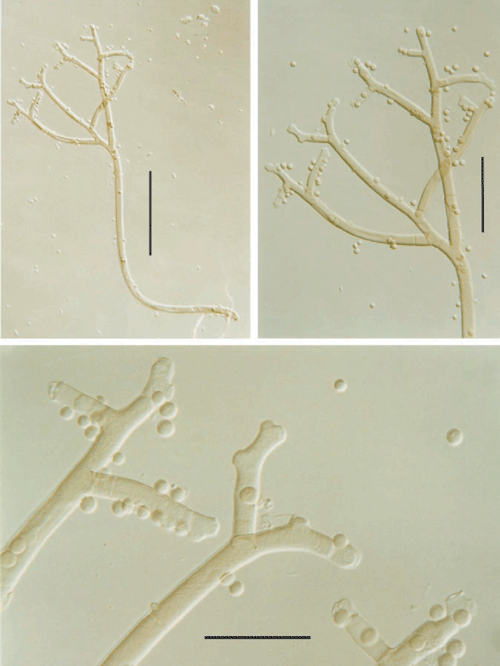Natural infection of Acalypha hispida and Jatropha podagrica inflorescences by Amphobotrys ricini in Brazil
B. V. Lima A , D. J. Soares A B , O. L. Pereira A and R. W. Barreto AA Departamento de Fitopatologia, Universidade Federal de Viçosa, Viçosa, MG 36570-000, Brazil.
B Corresponding author. Email: dartjs@yahoo.com.br
Australasian Plant Disease Notes 3(1) 5-7 https://doi.org/10.1071/DN08003
Submitted: 28 November 2007 Accepted: 15 January 2008 Published: 30 January 2008
Abstract
Amphobotrys ricini is recorded for the first time causing natural blight on inflorescences of the ornamental euphorbiaceous hosts Acalypha hispida and Jatropha podagrica in Brazil.
Acalypha hispida Willd., popularly known as ‘red hot cat’s tail’ or ‘chenille plant’ is a semiherbaceous shrub that belongs to the Euphorbiaceae and is native to India and the South Pacific Islands. Jatropha podagrica Hook., popularly known as ‘goutystalk nettlespurge’ or ‘Buddha belly plant’, is a small shrub with a swollen stem near the base, which is native to Central America and Antilles and also belongs to the Euphorbiaceae. Both are widely used as ornamental plants in Brazil and abroad (Lorenzi and Souza 1999). Between November 2006 and April 2007, blighted inflorescences of A. hispida were observed in Viçosa, state of Minas Gerais, Brazil. Later (May 2007), inflorescences of J. podagrica were also observed to have similar symptoms. In both cases the diseased parts showed a grey powdery mass and were constantly associated with a Botrytis-like fungus (Fig. 1). The fungus was isolated directly from diseased tissue, on Vegetal Broth Agar (VBA, Pereira et al. 2003) and based on its morphology [conidiophores cylindrical, up to 1000 μm long, about half height bifurcate at a wide angle, secondary branches almost symmetrical; terminal conidiogenous cells developing simultaneous conidial buds on short pedicels, collapsing at maturity; conidia globose, 5.5–9.0 μm diam., subhyaline to brown, smooth (Fig. 2)] and hosts was identified as Amphobotrys ricini (Buchw.) Hennebert [teleomorph: Botryotinia ricini (Godfrey) Wethzel (Hennebert 1973)]. This fungus is known to attack several euphorbiaceous hosts worldwide. Samples were deposited at the herbarium of the Universidade Federal de Viçosa (VIC 30476; VIC 30477).

|

|
To perform the inoculation tests, the fungus was cultivated on VBA and a conidial suspension was prepared from 10-day-old cultures and adjusted to 2 × 105 conidia/mL with the help of a Neubauer chamber. Healthy inflorescences of A. hispida, A. reptans Sw., J. podagrica, Ricinus communis L. and Manihot esculenta Crantz were spray-inoculated and covered with plastic bags for 24 h to simulate a dew chamber. Within 3–8 days, all inoculated inflorescences developed similar symptoms to those initially observed in the field on A. hispida and J. podagrica.
This fungus is the most important pathogen of castor bean (R. communis) and is also known to attack several other members of Euphorbiaceae (Godfrey 1923; Holcomb et al. 1989). In Brazil it was known only on R. communis and Euphorbia heterophylla L. (recorded as Botrytis ricini) (Barreto and Evans 1998; Mendes et al. 1998). Although members of Acalypha and Jatropha have already been reported as hosts of A. ricini, these reports referred to artificial inoculations (Godfrey 1923; Holcomb et al. 1989). So, this is the first record of natural infection of inflorescences of Acalypha and Jatropha by A. ricini worldwide.
Information on the host range of the grey mould of castor bean is of particular relevance in Brazil considering the growing importance of R. communis and J. curcas L. as sources of renewable fuels.
Barreto RW, Evans CH
(1998) Fungal pathogens of Euphorbia heterophylla and E. hirta in Brazil and their potential as weed biocontrol agents. Mycopathologia 141, 21–36.
| Crossref | GoogleScholarGoogle Scholar | PubMed |

Godfrey GH
(1923) Gray mold of castor bean. Journal of Agricultural Research 22, 679–715.

Hennebert GL
(1973) Botrytis and Botrytis-like genera. Persoonia 7, 183–204.

Holcomb GE,
Jones JP, Wells DW
(1989) Blight of prostrate spurge and cultivated poinsettia caused by Amphobotrys ricini. Plant Disease 73, 74–75.
| Crossref | GoogleScholarGoogle Scholar |

Pereira JM,
Barreto RW,
Ellison C, Maffia LA
(2003) Corynespora cassicola f. sp. lantanae: a potential biocontrol agent for Lantana camara from Brazil. Biological Control 26, 21–31.
| Crossref | GoogleScholarGoogle Scholar |



